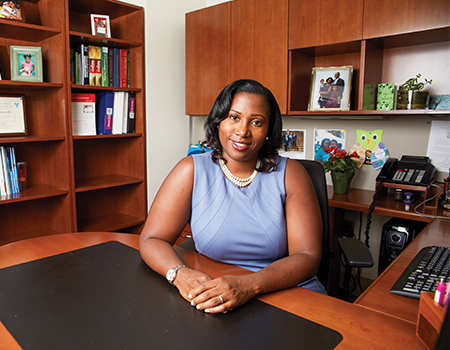 |
||||||||||||||||||||||||||||
|
||||||||||||||||||||||||||||
|
Improving Knowledge and Colposcopy Follow-Up for
“Multiple studies have shown that among underserved populations, there is from 20 to 40 percent nonadherence for colposcopy treatment,” says Eloise Chapman-Davis, MD, a specialist in gynecologic cancers in the Department of Obstetrics and Gynecology at NewYork-Presbyterian/Weill Cornell Medical Center. “Talking about disparities is one thing but trying to create interventions to make changes is something that I’m passionate about so that it doesn’t continue to happen.” Dr. Chapman-Davis, whose career has long focused on bringing advanced medical care to the underserved here and around the world, in collaboration with Monika M. Safford, MD, founder and Co-Director of the Cornell Center for Health Equity and Chief of General Internal Medicine at Weill Cornell Medicine, are developing a web-based intervention to educate and motivate women to continue with follow-up care, particularly those with abnormal Pap smears. “While we still have a significant number of patients in the U.S. with cervical cancer, the overall incidence and mortality from cervical cancer has dropped dramatically thanks to effective screening programs — except for Hispanic and African American women,” says Dr. Chapman-Davis. “The incidence and death from cervical cancer are definitely not equal across races/ethnicities or socioeconomic classes. Outcomes, in general, are worse with women who are uninsured, underinsured, and of low income. They may be diagnosed at later stages because they present later, or perhaps these patients have limited education and may not understand why follow-up is important. Even women who already have an abnormal Pap smear and who are at high risk are not following up. If we could treat them early on, we could prevent them from presenting later with advanced cancer and greatly reduce their risk of dying from this disease.” Dr. Chapman-Davis is focusing on patients who come to the colposcopy clinic in Weill Cornell’s Women’s Health Practice, which primarily serves low income, underserved women across multiple ethnicities. “These women already have an abnormal Pap smear,” she says. “The next step in the diagnosis and treatment of these precancerous lesions or cancer is usually a colposcopy.” With no-show rates for follow-up at the Women’s Health Practice as high as 30 to 40 percent, Dr. Chapman-Davis knew something had to be done. She turned to Dr. Monika Safford, who has achieved success in producing online, accessible, and easily understood medical information with the Patient Activated Learning System (PALS) for low literacy populations. In March 2017, PALS premiered online with its first round of medical information focused on hypertension. Since then, over 70,000 visitors from over 170 countries have accessed the site. “This is a perennial problem across the country, and our colposcopy clinic is no exception, unfortunately,” says Dr. Safford. “You’re dealing with an indigent population. Their telephone numbers turn over very frequently, and certified letters about the results of their biopsy come back addressee unknown. Then what do you do with that?” With funding from the Dean’s Diversity and Healthcare Disparity Research Award, Dr. Chapman-Davis enlisted Dr. Safford to generate pilot data through the PALS. “Our goal is to create engaging and informative videos and text based on information we draw from the patients’ initial interviews,” says Dr. Chapman-Davis. “These interviews reveal their baseline knowledge, what they believe the barriers to be, and the reasons why they’re not following up.” “Dr. Chapman-Davis identified large communication gaps in the colposcopy clinic where women don’t understand even basic information about Pap smears and very few women have heard of colposcopy,” says Dr. Safford. “Even if it had been explained to them several times, it didn’t necessarily register. Dr. Chapman-Davis was looking for some reinforcement.” Toward that goal, Dr. Safford and Dr. Chapman-Davis are developing an intervention configured for a smartphone or desktop application that provides a link to the PALS website at the time of the patient’s appointment reminder. This reminder will be in the form of a text message that explains in simple language the importance of keeping their appointment. “Our project is about engaging women, hearing their concerns, determining knowledge deficits, and developing content to answer their questions in language they can understand,” says Dr. Safford. “The initial phase of our study is to conduct the qualitative component to actually hear from patients. Based on those interviews, we will address their concerns through a library of eight to 10 videos in English and Spanish created at a 6th grade reading level,” says Dr. Chapman-Davis. “Once we develop the intervention, we want to pilot test it in the clinic with 40 patients between the ages of 18 and 65. We will provide tablets for them to view and help them work their way through the program. We also want to make sure that this is something that can be utilized at home, so part of our inclusion criteria is that everyone has to have a smartphone.” Fortunately, national and New York City data suggest that many residents who live in low-income neighborhoods have smartphones. The end points of the pilot study will be to evaluate feasibility, satisfaction, and knowledge retention of key concepts. Patients will be tested before and after the intervention to gauge how much knowledge they retained from the questions addressed in the videos. During the one-year timeline, the team will determine if this approach holds promise. “If we find that it does, we would want to put a larger grant proposal together and conduct this program across a number of clinics in large academic centers to see if we can really make a difference and convince women to come back and receive definitive treatment for their problem,” says Dr. Safford. “This would not only be a way to help train physicians about how to treat these underserved populations in a culturally competent way, but it can also help make sure that we physicians give patients the proper education,” adds Dr. Chapman-Davis. “Patients can access this information at home and, hopefully, that will help alleviate their worries and let them know what to expect before they even walk into the physician’s office.”
Maternal Mental Health:
There is increasing evidence that high levels of stress and depression can affect children long after birth, a major focus of investigations by Catherine Monk, PhD, Professor of Medical Psychology in the Departments of Obstetrics and Gynecology and Psychiatry, and Research Scientist VI at the New York State Psychiatric Institute. Dr. Monk, a clinical psychologist, brings together the fields of psychopathology, developmental neuroscience, and perinatal psychiatry to understand the earliest influences — those that happen in utero — on developmental trajectories of children and how to intervene to prevent mental health problems. “I straddle two worlds — women’s mental health and child development, with the understanding that children’s brains start developing in utero,” says Dr. Monk. “Much of my work focuses on pregnant and postpartum women, with the goal that when we’re helping a woman with stress, depression, or anxiety, we’re also potentially helping the next generation.” “There is an intense biological connection between the mother and the fetus, such that the mother’s lifestyle in essence is the fetus’s first environment,” explains Dr. Monk, who directs the Perinatal Pathways Laboratory. “Often now the saying is that the womb is as important as the home in terms of how children develop. We’re understanding that depression is, of course, very much a subjective, psychological experience, but it’s also happening on a biological level. If you’re depressed in pregnancy, these changes in biology amount to an altered in utero environment for the fetus.” Impact of Distress on the Developing Fetus In the May 2019 issue of the Annual Review of Clinical Psychology, Dr. Monk and her Columbia colleagues reviewed what is known about the prenatal developmental origins of future psychopathology. “In addition to shared genes and the postnatal environment, a third pathway for the familial inheritance of risk for mental illness is the prenatal environment,” notes Dr. Monk. “Epidemiological and observational clinical data demonstrate that maternal distress — defined broadly to include perceived stress, life events, depression, and anxiety — is related to children’s increased risk for psychopathology. For example, high maternal anxiety is associated with a two-fold increase in the risk of probable mental disorder in children.” Much of Dr. Monk’s research has centered on identifying the effects of maternal depression, anxiety, and stress before the baby is born, closely following birth, or just a few months afterwards in order to rule out postnatal influences on the developing child. In one study, Dr. Monk tested pregnant women, some of whom had untreated depression, anxiety, or high stress, using the Stroop Color Word Matching Task, an interference task that measures selective attention and cognitive flexibility and is known to make the tester feel pressured and stressed. “The test produces a certain amount of performance anxiety as the computer lets the women know if they are getting the answers wrong,” says Dr. Monk. “The test only lasts five minutes, but it does tell us on a scale of 1 to 10 how stressed the women are. At 8, 9, or 10 we can see that their blood pressure and respiration increase.” “The women’s blood pressure and respiration changes are a stimulus for the fetuses; some react, and some do not,” continues Dr. Monk. “What we’ve seen is that fetuses of depressed and anxious women are more reactive, and when we look at them at four months, they are also more reactive.” In another study of newborns, Dr. Monk and colleagues used brain imaging to test resting state functional connectivity between the amygdala, which is involved in fear response and emotions, and the prefrontal cortex. “The fetuses of depressed women showed less connectivity, so their prefrontal cortex was not able to calm down their amygdala,” she says. “The newborns who have less connectivity in this brain circuit had the greater heart rate response as fetuses. So, the emerging story is fetuses whose mothers are depressed or anxious, both in their behavior and their brain connectivity, are more reactive.”
Dr. Monk, as well as other researchers working in this area known as prenatal programming, believe a mother’s biological signals of stress, anxiety, or depression are a way to prepare the fetus for the postnatal environment. “If the mother is very stressed, anxious, or worried, she’s giving signals that it’s a tough world out there,” says Dr. Monk. “These biological signals to which the fetus is adapting may make the baby a more reactive child, and that might actually be beneficial if the world is threatening and dangerous. The problem is if the baby responds to a lot of stimuli and is very alert and reactive to the environment, then at age five or six they can develop in a way that looks like attention deficit hyperactivity disorder. They can’t pay attention and can’t match well to demands. This emphasizes the need to be thinking from a developmental perspective about where all these problems originate and how to prevent them.” Among the different pathways that Dr. Monk and her colleagues are exploring is the hypothalamic-pituitary-adrenal (HPA) axis and the stress hormone cortisol. “We have looked at a gene in the placenta that codes for an enzyme that deactivates cortisol as it crosses the placenta,” says Dr. Monk. “We found that when women had higher stress, this gene, through epigenetic processes, including methylation, got turned off. If it was highly methylated, then there would be more cortisol crossing into the fetal compartment, and the fetal brain would be exposed potentially to relatively atypical higher levels of cortisol.” Dr. Monk has also developed an intervention that begins during pregnancy to prevent postpartum depression. “My research and clinical practice are very interconnected and very gratifying,” she adds. “We should be treating women for themselves and also in their transition to parenting. With a prevention focus, we can intervene during pregnancy for the mother and for her future child. We are working with our obstetrics colleagues to identify and treat distress before it becomes significant depression. It’s great to start there, because that’s really the origin of future well-being, of children, and of families.” Dr. Monk now is putting her research into practice. She is heading up a new initiative in Obstetrics and Gynecology embedding women’s mental health services alongside routine prenatal and postnatal care — greatly expanding access to care by reducing logistical and scheduling challenges. Her team also is leveraging telemedicine to ensure women’s mental health needs are met independent of traveling and scheduling issues. Says Dr. Monk, “We are taking our work, and that of many other researchers, and having it directly inform our clinical mission.”
|
||||||||||||||||||||||||||||
|
||||||||||||||||||||||||||||
|
© NewYork-Presbyterian NewYork-Presbyterian Corporate Office |
||||||||||||||||||||||||||||





